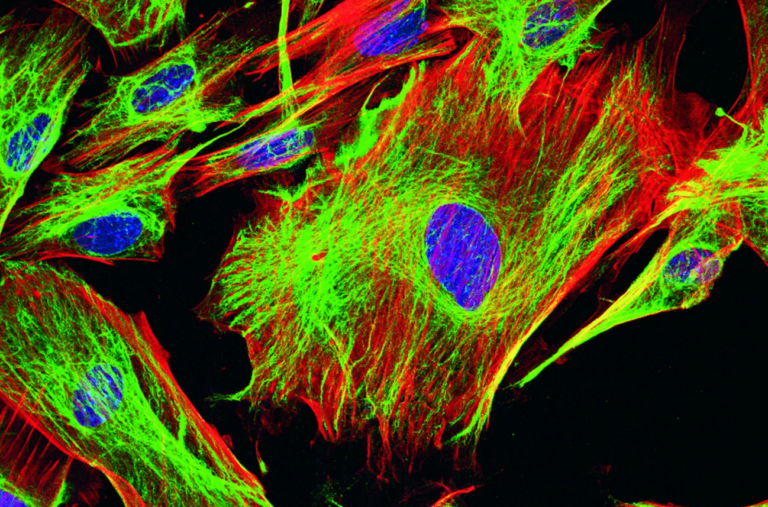Physicists from Around the World Investigate Microscopic Filament Behavior
Recently-published research from an international team of physicists reveals how the three-dimensional shape of rigid microscopic filaments determines their dynamics when suspended in water, and how control of that shape can be used to engineer solid-like behavior even when the suspension is more than 99% water.
The paper, “Bonded straight and helical flagellar filaments form ultra-low-density glasses,” was co-authored by Georgetown physics professors Peter Olmsted and Jeffrey Urbach and graduate student Matthew Sartucci. It has been published in the Proceedings of the National Academy of Sciences (PNAS).
“This work shows that we can use particle shape to create a material that forms an extremely low density glass,” said Urbach. “We’ve engineered thin filaments whose geometry creates a frustrated, completely jammed solid even though there is no chemical linking between the filament, and they take up only a very small fraction of the space”
The study leverages the remarkable properties of the flagella of bacteria—the microscopic “tails” that the organisms use for propulsion. For most bacteria, the flagella are rigid helical filaments, which the bacteria rotate to generate propulsive force, somewhat like the propeller of a really really tiny ship.
There are mutant strains of bacteria that grow flagella that are straight, rather than helical, and by using novel synthesis techniques, the group at UC Santa Barbara, led by Prof. Zvonimir Dogic, was able to generate chimeric filaments, composed of a segment of straight flagella fused to a helical one. Other team members included Ph.D. students at Georgetown and Brandeis Universities, as well as a research scientist at the Centre national de la recherche scientifique (CNRS) in Lyon, France.

When suspended in water, these tiny filaments exhibit Brownian Motion, the random fluctuations in position described by the botanist Robert Brown in 1827 when observing pollen grains under a microscope, and quantitatively explained by Albert Einstein in 1905, providing one of the first widely-accepted demonstrations of the existence of atoms and molecules. The PNAS study investigated the dramatic changes that can occur when a bunch of the filaments are added to the suspension.
The straight filaments are free to diffuse along their length, and thus stay mobile even though they are partially caged by their neighbors. The helical filaments can also diffuse along their length, but only by “corkscrewing” to escape their cages. For the chimeric filaments, by contrast, the straight tails suppress the corkscrewing, and as a result the filaments are completely stuck, even though the filaments only take up a very small fraction of the suspension volume.
The group investigated how this caging affected the mechanical properties of the suspension, and in particular they performed precise measurements of the stiffness of the material. They showed that the straight and helical filament suspensions behave like viscous liquids, while the chimeric filaments produce a glass-like solid, albeit a very soft one.
This work shows that shape can be used to control dynamics and mechanics, leveraging the remarkable properties of self-assembled natural materials. Emerging technologies will enable researchers to fabricate similar shapes from synthetic materials, providing powerful avenues for engineering adaptive materials with novel properties.
“The dramatic influence of shape on mechanics could dovetail with another topical area, that of dynamically shape-changing metamaterials,” said Olmsted. “In the future one could design materials from analogous objects that can switch between fluid and solid (glass) by a chemical, optical, or electrical trigger, in applications such as robotics, protective devices and equipment, and (re)structuring fabrics.”

This article is republished from PhysORG under a Creative Commons license. Read the original article.
Do not forget to share your opinion with us to provide you with the best posts !




0 Comments